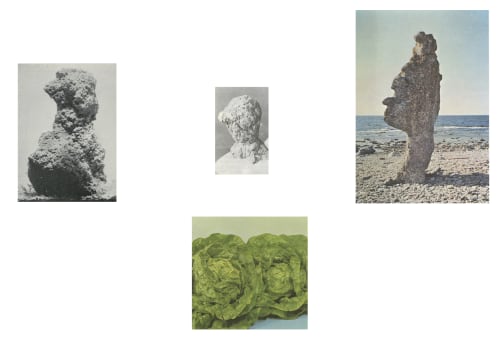Each piece by Ruth van Beek begins with the artist delving into her mammoth archive. Ruth’s collection of imagery is a treasure trove of inspiration.
It’s also the backbone of her work, providing her material and is her secret weapon, allowing her to experiment with collaging or pairing imagery and therefore experiment with the audience’s perception of it too. For the artist, she actually considers it “like a greenhouse,” she tells It’s Nice That “where I experiment with growing all sorts of stories of characters” – which is definitely the case for the latest book, How To Do The Flowers.
The images in Ruth’s archive are vast, “ranging from instruction books on cooking, flower arranging, gardening and handicraft to books on history, antiques and archaeology,” she tells us. However as a viewer, you’d never know about the imagery’s history as by “cutting the images from the books I have removed their original context and function,” explains the artist. “Together they are organised in a very personal way, in categories that seem important to me at this moment in time… Sometimes these are abstract constructions, sometimes they remind me of things happening in real life.”
Considering the majority of her work develops from delving into books, Ruth considers it only right for her to filter back into a publication format which provides “a context for the work and gives them a place to be replicated and spread,” she suggests. How To Do The Flowers shows this case and point working as both as an archive of her works “and at the same time makes a manual book for myself, a manual to make a new work.”
When Ruth says it’s a manual, she is being slightly abstract but in reality, How To Do The Flowers began with manual instructions the artist had found in books. The publication’s title of a “How To” consolidates this concept, as well as a giant hand, a tool we all possess, sitting proudly on its front cover. “All these hands making things, it was like a mirror for myself,” she tells us. “I think they have always played a role in making work since I looked at them so often and I am in my studio looking for new ideas. So, making this book was also a way of making this work process public and insightful.”
In terms of process, Ruth began by enlarging miniature sketches to make into collages, “they are made fast and you can recognise that,” she says, “but when they are enlarged in the book, suddenly accidental little details become very important.” In turn, tiny details expose themselves for interpretation, “a little something that comes out from under the covering can become a nose or an ear,” for instance, “some of them have simple shapes sticking out that could be the beginning of arms. They became the key to making the book.”
As a result, despite being a physical object to flick through and visually inspect, Ruth sees the books as being about animating. “About how I want to see something alive in things that are still abstract,” she says. “I play with this idea of animation through the book. The hands are building a body, forming it and turning it into a living being. A little helper or a Frankenstein. I haven’t figured it out yet.” Just as Ruth is yet to decipher many elements of the book, there is just as much for audiences to figure out themselves.
How To Do The Flowers is available here.

